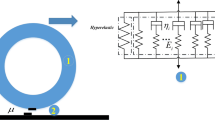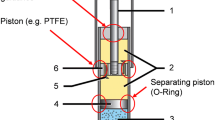Abstract
The purpose of this study was to effectively identify parameters for a LuGre friction model based on experimental measures. In earlier work related to this study (Yang et al., 2009), which was based on the characters of polygonal wear (Sueoka and Ryu, 1997), we showed a frictional vibration model for a mass on a moving belt. This model reflected lateral vibrations caused by velocity and toe-in angle. An important aspect of the present study is the improved friction model. A previous friction model, which divided the process into four parts, expressed the sable excited vibration well but failed to reflect the hysteresis loop change when vehicles accelerated or decelerated continuously. A LuGre friction model can solve this problem, but several model parameters must be obtained experimentally. We measured contact width and length of tires as vertical pressure changed; this provided a theoretical basis for apparent stiffness of a unit of tire tread. Based on tire data from Bakker E’s article in a SAE paper from 1987, we identified the Stribeck exponent and Stribeck velocity in LuGre. Then, the results were implemented in a vibration system that verified the rationality of the data.
Similar content being viewed by others
References
Bakker, E., Nyborg, L. and Pacejka, H. (1987). Tire modelling for use in vehicle dynamic studies. SAE Paper No. 870421.
Canudas de Wit, C., Olsson, H., Astrom, K. J. and Lischinsky, P. (1995). A new model for control of systems with friction. IEEE Trans. Automation Control 40,3, 419–425.
Deur, J., Asgari, J. and Hrovat, D. (2001). A dynamic tire friction model for combined longitudinal and lateral motion. Proc. ASME Int. Mechanical Engineering Cong. and Exposition, New York.
Jensen, J. S. (1998). Non-linear dynamics of the followerloaded double pendulum with added support-excitation. J. Sound and Vibration, 215, 125–142.
McMillan, J. (1997). A non-linear friction model for selfexcited vibrations. J. Sound and Vibration, 205, 323–335.
Sueoka, A. and Ryu, T. (1997). Polygonal wear of automobile tire. JSME, 40, 209–217.
Thomsen, J. J. (1999). Using fast vibrations to quench friction-induced oscillations. J. Sound and Vibration, 228, 1079–1102.
Wu, X., Zuo, S. and Lei, L. (2008). Study on a friction coefficient model for self-excited vibrations of tire. IEEE Vehicle Power and Propulsion Conf.
Yang, X., Zuo, S. and Lei, L. (2009). Dynamics stability analysis of tire’s non-linear self-excited vibration. China Mechanical Engineering, 10, 1251–1254.
Author information
Authors and Affiliations
Corresponding author
Rights and permissions
About this article
Cite this article
Wu, X.D., Zuo, S.G., Lei, L. et al. Parameter identification for a LuGre model based on steady-state tire conditions. Int.J Automot. Technol. 12, 671–677 (2011). https://doi.org/10.1007/s12239-011-0078-9
Received:
Revised:
Published:
Issue Date:
DOI: https://doi.org/10.1007/s12239-011-0078-9




